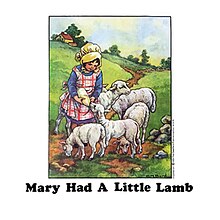Mary Had a Little Lamb (Wings song)
| "Mary Had a Little Lamb" | ||||
|---|---|---|---|---|
 Picture sleeve | ||||
| Single by Wings | ||||
| B-side | "Little Woman Love" | |||
| Released | 12 May 1972 | |||
| Recorded | March 1972 | |||
| Genre | Children's music | |||
| Length | 3:30 | |||
| Label | Apple | |||
| Songwriter(s) | Paul McCartney, Linda McCartney | |||
| Producer(s) | Paul McCartney | |||
| Wings singles chronology | ||||
| ||||
"Mary Had a Little Lamb" is a song written by Paul and Linda McCartney and released as a non-album single by the British–American rock band Wings in March 1972. It is based on the traditional nursery rhyme of the same name.
Background[]
At the time, some observers such as Roy Carr and Tony Tyler of New Musical Express presumed the song was recorded by McCartney in response to the BBC ban of his previous single, the political "Give Ireland Back to the Irish",[1] but McCartney has denied this, saying that it was a sincere effort to write a song for children.[2] In fact, the song was written before "Give Ireland Back to the Irish", as a demo of the song can be heard during an interview recorded for radio station WRKO in December 1971.[3]
Charts and reception[]
"Mary Had a Little Lamb" was released as a single on 12 May 1972 in the UK,[4] moved back from its original planned date of the 5th.[5] The record was released in the US on 29 May.[5] On 25 May, the band mimed a performance of the song for BBC TV's Top of the Pops TV show.[5]
The song was attacked by several contemporary rock critics, with one commenting that McCartney had "fallen to tripe" of this genre.[6] However, some critics suspected this immediate change in musical direction to be a deliberately ironic musical manoeuvre.[7] It reached the top 10 in the UK, peaking at number nine.[8] Some US radio stations also played the pop/rock B-side, "Little Woman Love". Apple Records in the US even revised the picture sleeve for the single to credit both sides by name (see reverse cover), but the single still failed to rise above number 28 in the US.[9]
Charts[]
| Chart (1972) | Peak
position |
|---|---|
| Australian Go-Set National Top 40[10] | 17 |
| Canadian RPM Top 100[11] | 41 |
| Japanese Oricon Singles Chart | 41 |
| UK Singles Chart[12] | 9 |
| US Billboard Hot 100[13] | 28 |
| US Cash Box Top 100[14] | 48 |
| US Record World Singles Chart[14] | 38 |
References[]
- ^ Carr, Roy; Tyler, Tony. The Beatles: An Illustrated Record (1975) p. 100
- ^ Garbarini, Vic (1980). The McCartney Interview [interview LP], Columbia Records.
- ^ Luca Perasi, Paul McCartney: Recording Sessions (1969–2013), L.I.L.Y. Publishing, 2013, ISBN 978-88-909122-1-4, p.79.
- ^ Castleman, Harry; Podrazik, Walter J. (1977). All Together Now – The First Complete Beatles Discography 1961–1975 (Second ed.). New York: Ballantine Books. p. 113. ISBN 0-345-25680-8.
- ^ Jump up to: a b c Miles, Barry; Badman, Keith, eds. (2001). The Beatles Diary After the Break-Up: 1970-2001 (reprint ed.). London: Music Sales Group. ISBN 9780711983076.
- ^ Band on the Run: A History of Paul McCartney and Wings ISBN 978-0-878-33304-2 p. 27
- ^ Dempsey, J.M. "McCartney at 60: a body of work celebrating home and hearth", Popular Music & Society, February 2004.
- ^ "Official Charts: Paul McCartney". The Official UK Charts Company. Retrieved 2011-10-13.
- ^ "Paul McCartney Charts and Awards". allmusic. Retrieved 2011-10-13.
- ^ "Go-Set Australian Charts – 20 May 1972". poparchives.com.au. Retrieved 5 December 2017.
- ^ "RPM Top Singles - Volume 17, No. 10 (April 22, 1972)". Library and Archives Canada. 17 July 2013. Retrieved 5 December 2017.
- ^ "Give Ireland Back to the Irish (Search results)". Official Charts Company. Retrieved 5 December 2017.
- ^ "Paul McCartney: Awards" > "Billboard Singles". AllMusic. Archived from the original on 9 June 2012. Retrieved 5 December 2017.
- ^ Jump up to: a b McGee 2003, p. 244.
- Paul McCartney songs
- 1972 singles
- Apple Records singles
- Wings (band) songs
- Songs written by Paul McCartney
- Songs written by Linda McCartney
- Song recordings produced by Paul McCartney
- Music published by MPL Music Publishing
- Songs based on children's songs
- Songs about shepherds
- Songs about sheep